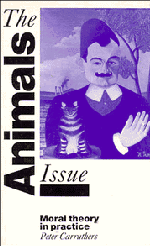Book contents
- Frontmatter
- Contents
- Preface
- 1 Moral argument and moral theory
- 2 Utilitarianism and contractualism
- 3 Utilitarianism and animal suffering
- 4 Utilitarianism and the harm of killing
- 5 Contractualism and animals
- 6 Animals and rational agency
- 7 Contractualism and character
- 8 Animals and conscious experience
- Conclusion
- Notes
- Index
8 - Animals and conscious experience
Published online by Cambridge University Press: 03 May 2011
- Frontmatter
- Contents
- Preface
- 1 Moral argument and moral theory
- 2 Utilitarianism and contractualism
- 3 Utilitarianism and animal suffering
- 4 Utilitarianism and the harm of killing
- 5 Contractualism and animals
- 6 Animals and rational agency
- 7 Contractualism and character
- 8 Animals and conscious experience
- Conclusion
- Notes
- Index
Summary
In this chapter I shall explore a challenge to something we have taken for granted throughout our investigation of the moral standing of animals, at least since Chapter 3. The assumption in question is that animal experiences (particularly pain) are sufficiently similar to our own to be appropriate objects of moral concern.
CONSCIOUS VERSUS NON-CONSCIOUS
I shall begin by drawing a distinction between two different kinds of mental state, that is particularly vivid in the case of experience. While not exactly a common-sense distinction, it is easily recognised when pointed out. Consider some familiar examples. Suppose that Abbie is driving her car over a route she knows well, her conscious attention wholly abstracted from her surroundings. Perhaps she is thinking deeply about some aspect of her work, or fantasising about her next summer holiday, to the extent of being unaware of what she is doing on the road. Suddenly she ‘comes to’, returning her attention to the task in hand with a startled realisation that she has not the faintest idea what she has been doing or seeing for some minutes past. Yet there is a clear sense in which she must have been seeing, or she would have crashed the car. Her passenger sitting next to her may correctly report that she had seen a vehicle double-parked by the side of the road, for example, since she deftly steered the car around it.
- Type
- Chapter
- Information
- The Animals IssueMoral Theory in Practice, pp. 170 - 193Publisher: Cambridge University PressPrint publication year: 1992



